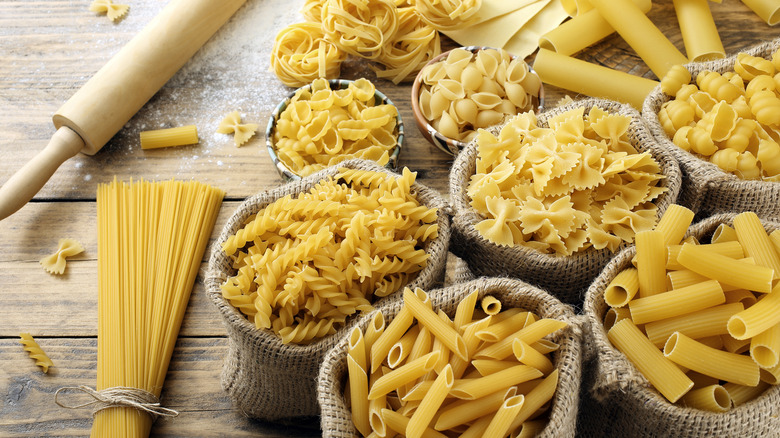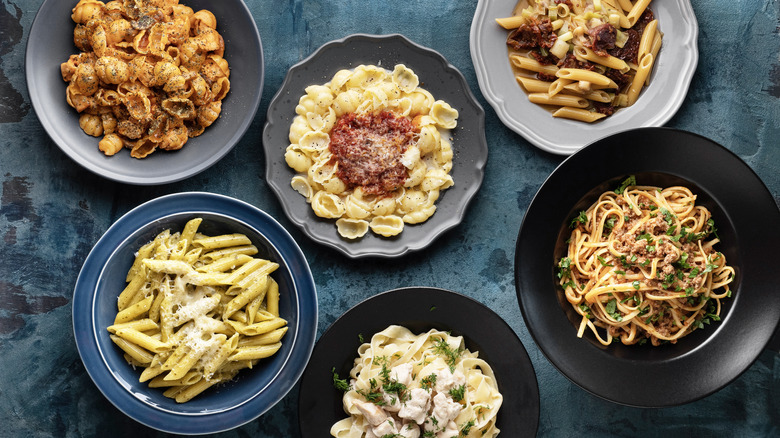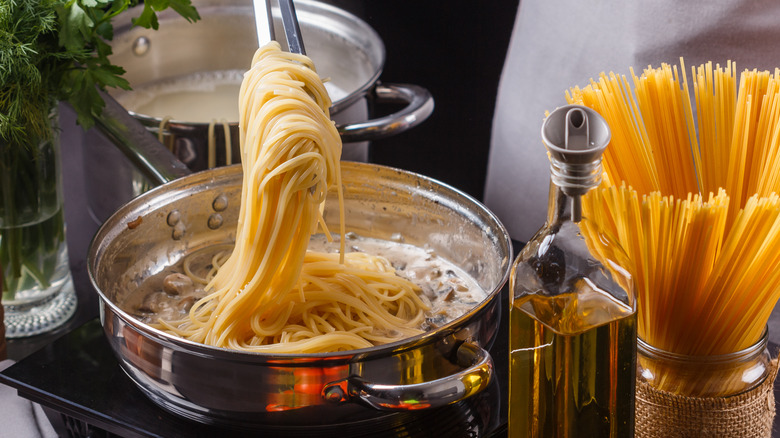Your Pasta Shape Matters A Lot More Than You'd Think
There are so many kinds of noodles you may need a guide to pasta shapes to navigate them all. But what do you do with such variety? Well, with a great many pasta shapes comes a great responsibility: picking the right one. The form your pasta takes has a huge impact on your dish as a whole — so while you may be accustomed to focusing purely on the sauce, you can't make the right match without showing some love to the noodle itself.
Choosing the correct pasta doesn't have to be a complicated battle. The wrong noodle will leave your sauce swimming at the bottom of your bowl, while the right one will give you a bite full of flavor. When selecting your pasta, think of your sauce and how certain noodles are designed to trap ingredients within their twists and turns while others have a more open structure for catching sauce, and still others let the sauce stick more easily. Turning your attention to the qualities of your pasta sauce will be the key to accompanying it with the right pasta shape.
Match your pasta shape to the sauce you're using
Nobody likes a bland bite of food, especially when pasta is designed to be the vessel for other ingredients in your dish. While pastas such as fusilli and wagon wheel have fun shapes, they also have a job to do: those shapes have crevices for sauces to sink into. That's why curly noodles such as rotini or cavatappi are often served with a chunky meat or vegetable sauce — the bulkier ingredients have a place to nestle within the pasta's nooks. This can also be applied to finer yet still thick sauces, like how the herbs in basil pesto rest in the troughs of a traditional twirly gemelli noodle.
But what about using a less chunky sauce? Remember this helpful hint: Smooth sauces like simple noodles. Pastas such as farfalle, lasagna, and fettuccine have a flatter surface area meaning your Alfredo or marinara will completely blanket your pasta. A rich sauce will coat a flat pasta more evenly, given there are no hidden spaces for the sauce to clump inside of. Note that oil-based sauces are better suited to long, thin pasta that will swim in the sauce and soak up the oils more readily. Also, pairing a lighter buttery sauce like cacio e pepe with hearty spaghetti gives you the slurping satisfaction of a classic pasta experience.
More ways to marry your pasta to your sauce
Tubular pastas such as penne or ziti serve as the wrapping paper for the gift of sauce. While a traditional Bolognese ragu may be served with pappardelle or fettuccine, many recipes opt for a tube-shaped noodle like rigatoni that allows the sauce to settle inside. The larger the tube, the chunkier the ingredients can be. Speaking of size, we can't count out smaller pastas like stelline and orzo which are perfect in soups or broths. They're scoopable and very filling — and are usually served in a lighter broth that doesn't weigh them down, or a simple soup where the pasta isn't lost amongst chunkier ingredients.
Now, you can't just dump the sauce on top of a pile of plain noodles. Avoid sauceless bites by finishing the pasta in the sauce itself. Simply heat your sauce on high in a large saucepan and remove your noodles from their boiling water a minute early to add them directly into the sauce. As they finish cooking they'll absorb the flavor of the sauce while getting evenly coated. Ladle some of the pasta water into the pan with the sauce and pasta to help them cling to one another.
Starting with the right pasta shapes for your sauce and finishing your dish with these tips will make for the perfect pairing. But if you can't find the exact shape you're looking for, go for a similar shape and style — they're usually grouped next to each other at the store for ease.


